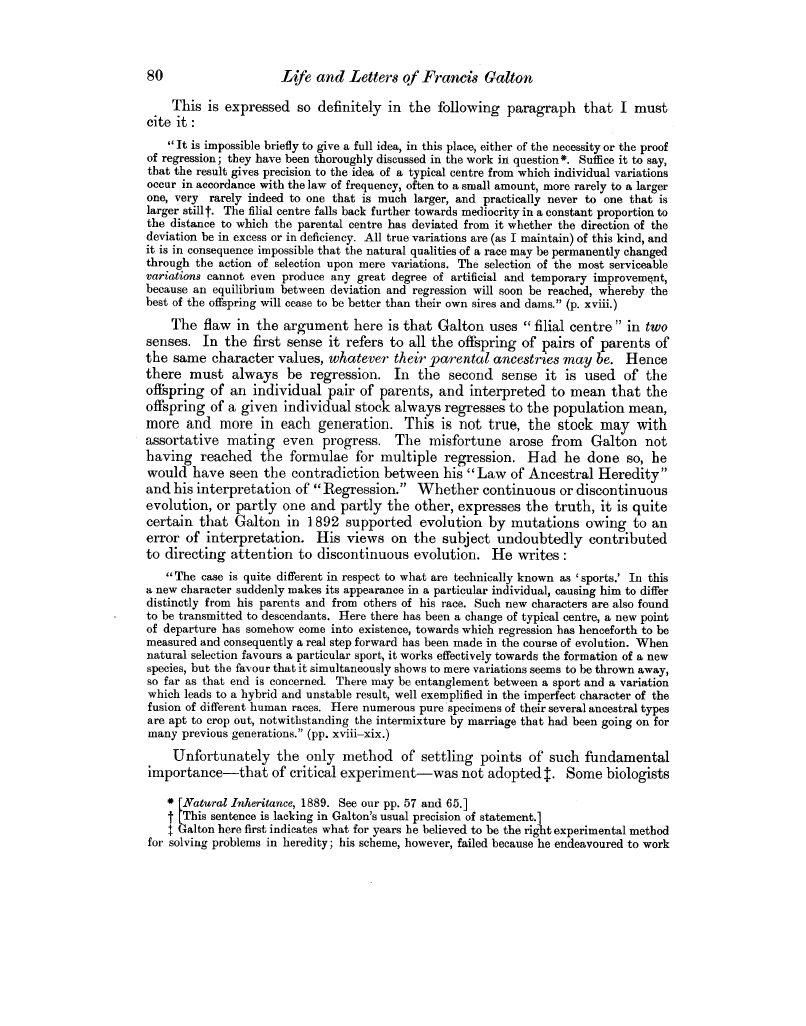| ||||||

OCR Rendition - approximate
80 Life and Letters of Francis Galton This is expressed so definitely in the following paragraph that I must cite it " It is impossible briefly to give a full idea, in this place, either of the necessity or the proof of regression; they have been thoroughly discussed in the work in question*. Suffice it to say, that the result gives precision to the idea of a typical centre from which individual variations occur in accordance with the law of frequency, often to a small amount, more rarely to a larger one, very rarely indeed to one that is much larger, and practically never to one that is larger still t. The filial centre falls back further towards mediocrity in a constant proportion to the distance to which the parental centre has deviated from it whether the direction of the deviation be in excess or in deficiency. All true variations are (as I maintain) of this kind, and it is in consequence impossible that the natural qualities of a race may be permanently changed through the action of selection upon mere variations. The selection of the most serviceable variations cannot even produce any great degree of artificial and temporary improvement, because an equilibrium between deviation and regression will soon be reached, whereby the best of the offspring will cease to be better than their own sires and dams." (p. xviii.) The flaw in the argument here is that Galton uses " filial centre " in two senses. In the first sense it refers to all the offspring of pairs of parents of the same character values, whatever their parental ancestries may be. Hence there must always be regression. In the second sense it is used of the offspring of an individual pair of parents, and interpreted to mean that the offspring of a given individual stock always regresses to the population mean, more and more in each generation. This is not true, the stock may with assortative mating even progress. The misfortune arose from Galton not having reached the formulae for multiple regression. Had he done so, be would have seen the contradiction between his "Law of Ancestral Heredity" and his interpretation of "Regression." Whether continuous or discontinuous evolution, or partly one and partly the other, expresses the truth, it is quite certain that Galton in 1892 supported evolution by mutations owing to an error of interpretation. His views on the subject undoubtedly contributed to directing attention to discontinuous evolution. He writes "The case is quite different in respect to what are technically known as 'sports.' In this a new character suddenly makes its appearance in a particular individual, causing him to differ distinctly from his parents and from others of his race. Such new characters are also found to be transmitted to descendants. Here there has been a change of typical centre, a new point of departure has somehow come into existence, towards which regression has henceforth to be measured and consequently a real step forward has been made in the course of evolution. When natural selection favours a particular sport, it works effectively towards the formation of a new species, but the favour that it simultaneously shows to mere variations seems to he thrown away, so far as that end is concerned. There may be entanglement between a sport and a variation which leads to a hybrid and unstable result, well exemplified in the imperfect character of the fusion of different human races. Here numerous pure specimens of their several ancestral types are apt to crop out, notwithstanding the intermixture by marriage that had been going on for many previous generations." (pp. xviii-xix.) Unfortunately the only method of settling points of such fundamental importance-that of critical experiment-was not adopted $. Some biologists Natural Inheritance, 1889. See our pp. 57 and 65.] t This sentence is lacking in Galton's usual precision of statement.] I alton here first indicates what for years he believed to be the right experimental method for solving problems in heredity; his scheme, however, failed because he endeavoured to work
|